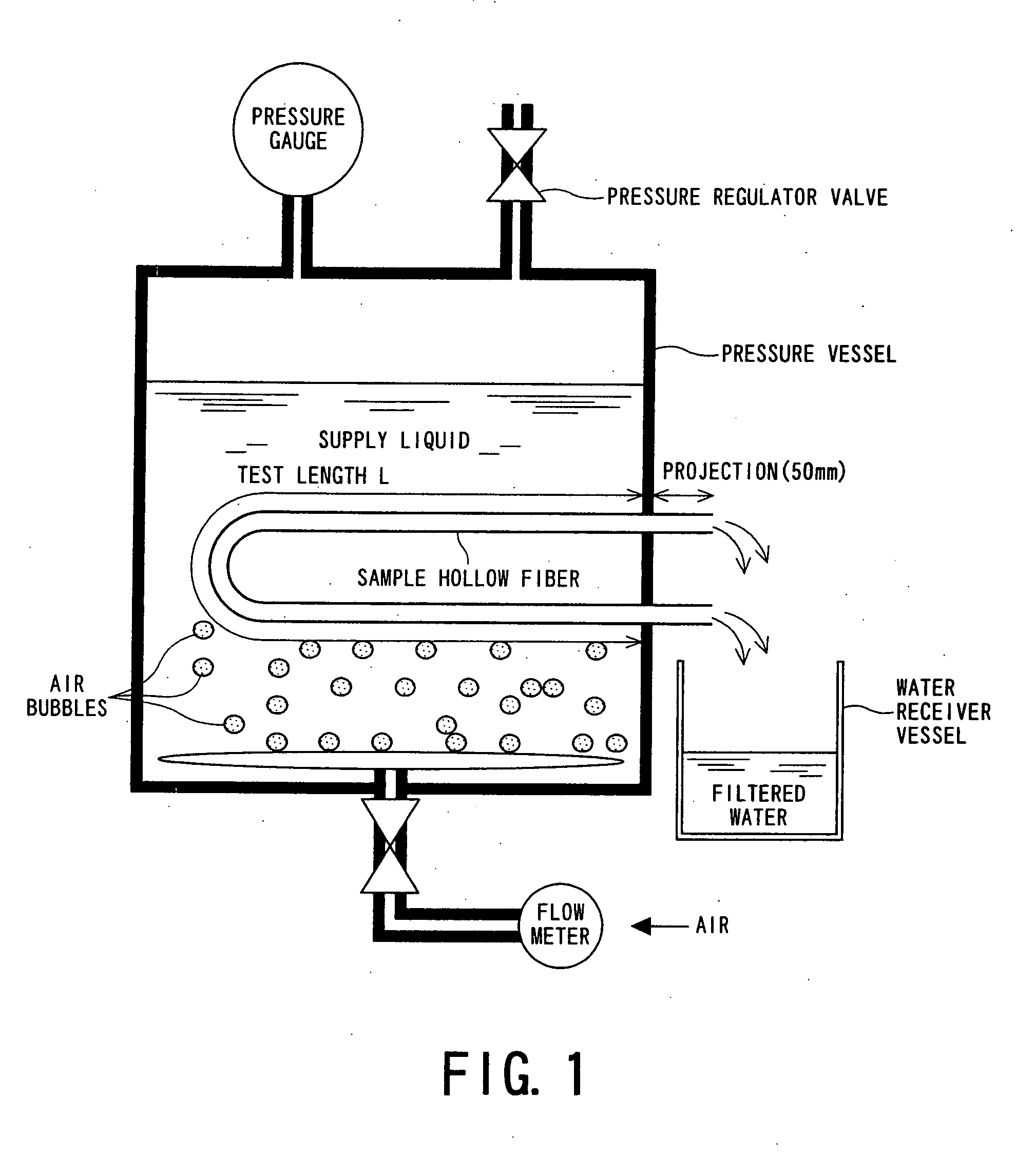Vinylidene Fluoride Resin Hollow Filament Porous Membrane, Water Filtration Method Using the Same, and Process for Producing Said Vinylidene Fluoride Resin Hollow Filament Porous Membrane
a technology porous membrane, which is applied in the direction of membranes, separation processes, filtration separation, etc., can solve the problems of affecting the mechanical performance of porous membranes, the inability to obtain porous membranes having necessarily satisfactory mechanical performances, and the deterioration of vinylidene fluoride resin constituting the membrane, etc., to achieve excellent mechanical strength and long-term water treatment performance.
- Summary
- Abstract
- Description
- Claims
- Application Information
AI Technical Summary
Benefits of technology
Problems solved by technology
Method used
Image
Examples
example 1
[0086]A principal polyvinylidene fluoride (PVDF) (powder) having a weight-average molecular weight (Mw) of 4.12×105 and a crystallinity-modifier polyvinylidene fluoride (PVDF) (powder) having Mw=9.36×105 were blended in proportions of 95 wt. % and 5 wt. %, respectively, by a Henschel mixer to obtain a mixture A having Mw=4.38×105.
[0087]An adipic acid-based polyester plasticizer (“PN-150”, made by Asahi Denka Kogyo K.K.) as an aliphatic polyester and N-methyl-pyrrolidone (NMP) as a solvent were mixed under stirring in a ratio of 82.5 wt. % / 17.5 wt. % at room temperature to obtain a mixture B.
[0088]An equi-directional rotation and engagement-type twin-screw extruder (“BT-30”, made by Plastic Kogaku Kenkyusyo K.K.; screw diameter: 30 mm, L / D=48) was used, and the mixture A was supplied from a powder supply port at a position of 80 mm from the upstream end of the cylinder and the mixture B heated to 160° C. was supplied from a liquid supply port at a position of 480 mm from the upstream...
example 2
[0094]The principal PVDF and the modifier PVDF were blended in proportions of 90 wt. % and 10 wt. %, respectively, to obtain a mixture A.
[0095]A hollow-fiber porous membrane was obtained in the same manner as in Example 1 except for using the mixture A and extruding a molten mixture of the mixture A and the mixture B at an increased nozzle ejection rate of 13.6 g / min. into a hollow fiber-form while supplying air at an increased rate of 4.8 ml / min. to the nozzle center, followed by cooling and solidification by introduction into a cooling bath at 10° C. to form a first intermediate form and stretching of a second intermediate form at a ratio of 1.8 times.
example 3
[0096]A hollow-fiber porous membrane was obtained in the same manner as in Example 2 except for using a mixture A having Mw=4.91×105 obtained by blending the principal PVDF and the modifier PVDF in proportions of 85 wt. % and 15 wt. %, respectively.
PUM
| Property | Measurement | Unit |
|---|---|---|
| porosity | aaaaa | aaaaa |
| mol % | aaaaa | aaaaa |
| melting point Tm2 | aaaaa | aaaaa |
Abstract
Description
Claims
Application Information
 Login to View More
Login to View More - R&D
- Intellectual Property
- Life Sciences
- Materials
- Tech Scout
- Unparalleled Data Quality
- Higher Quality Content
- 60% Fewer Hallucinations
Browse by: Latest US Patents, China's latest patents, Technical Efficacy Thesaurus, Application Domain, Technology Topic, Popular Technical Reports.
© 2025 PatSnap. All rights reserved.Legal|Privacy policy|Modern Slavery Act Transparency Statement|Sitemap|About US| Contact US: help@patsnap.com


